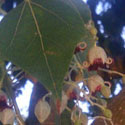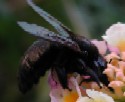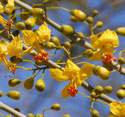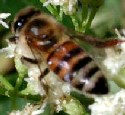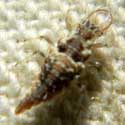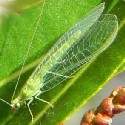April
Apr. 28, 2011: In neighbors' yards and along city avenues Kurrajong trees are blooming furriously with nary a bee of butterfly to appreciate them. Well, the name, derived from the Aboriginal language should give a clue as to why. This plant's pollinators are back in Australia where the tree belongs. Dark green leaves and heavy shade have made this a popular tree in hot climates like Phoenix, Arizona, and Palm Springs, California. But they add little to local ecology because virtually no insects are present. In my view, insects are a necessary part of a healthy garden.
Apr. 18, 2010: The Blue Palo Verde (Parkinsonia florida) in my patio has reached its peak blooming. The tree is nearly 4 m in height and has thousands of bright flowers open & attended by many bees: Carpenter Bees, Alkali Bees, Leaf-cutters and Honey Bees. It is a truly spectacular sight. By next week my yard and many avenues and sidewalks throughout Phoenix will be covered with fallen yellow confetti. In natural areas along desert washes these petals would be avidly gathered by leaf cutting ants for the cultivation of underground mushroom gardens. In the city they get swept away along with cigarette butts and leaves by noisy, air-polluting leaf-blowers.
Apr. 13, 2006: March brought some cooler than normal weather and even some precipitation that broke a nearly 5-month-long drought. Now today temperatures were pushing close to record highs - nearly 37 C. Blazing summer soon. The Blue Palo Verde is at peak blooming and the Soapberry is beginning to leaf out.
During the past week I added two new bird species to my yard list as they moved over and through on their migration route. A small flock of honking Canada Geese caught my attention flying high overhead and last night the distinctive call of a Common Poorwill was distinctly heard.
Apr. 16, 2002: An uncommon visitor to my patio-sanctuary, the Green-tailed Towhee, has been paying regular and frequent visits for the past week. It is a smaller cousin to Abert's Towhee. The Green-tailed Towhee is a nearly uniform gray-brown bird with a greenish sheen and a rusty brown cap. It forages by thoroughly kicking leaves and twigs off the soil surface to reveal grubs, seeds and sprouts. It is quite wary and is quick to disappear behind a dense shrub in response to any movement or sound. By summer this bird will likely join other green-taileds in the mountains and brush country of Utah, Nevada or western Wyoming.
Apr. 9, 2002: About a dozen founding female Brown Ambrosia Aphids have finally arrived at the Canyon Ragweed. Soon there could be hundreds of aphids crowded onto the growing tips. Eventually predators will find the aphid bonanza in my yard including, aphid lions, syrphid larvae, and especially braconid wasps. In 1998 I documented in detail the trials and tribulations of an Ambrosia Aphid colony.
Aphid Lions (Chrysopa), are the immature stage of the delicate green lacewing. As implied by this moniker, lacewing larvae are fierce predators bearing huge sickle-shaped mandibles that are hollow. The aphids' best defense, kicking, is thwarted as the lion skewers the aphid and holds it aloft, quickly extracting its contents through the mandibles.
A sticky, slimy coating keeps legless syrphid larva in contact with the plant surface at it scurries serpent-wise in search of aphid prey. Equipped with a pair of sharp, forward projecting skewers, it stabs an aphid and shoves it into the air just like the aphid lion. The empty hulls are tossed from the plant before the larva goes in search of its next meal. Syrphids mature into attractive, docile, yellow and black hover flies that can maneuver like helicopters as they visit flowers for nectar.
As if these predators weren't enough, the aphids must also deal with Aphid Wasps (Braconidae). Roughly the same size as a mature aphid, an adult braconid looks like tiny winged ant. At the terminus of its abdomen is a sharp, syringe-like ovipositor. The mother wasp approaches a smallish aphid, which attempts to kick or flee, but the wasp quickly flexes the abdomen forward slipping the sharp ovipositor into the body of the aphid. A minute egg travels down the tube and is deposited into the aphid. In a few hours the egg hatches into a minute grub that feeds upon the developing aphid from within. The timing is perfect so that just as the aphid reaches full size, so does the foreign body within. The aphid becomes a mere shell inside which the braconid grub turns to a resting pupa. After a couple of days the completely metamorphosed wasp emerges with gossamer wings leaving behind a golden brown shell that was the aphid! Such shells are easy to find amongst aphid colonies and should offer hope to gardeners that the aphid numbers will soon be in check.
With so many hungry predators ravaging the colony, the aphids only recourse is to develop wings themselves and fly off. Only the lucky will survive that long.
April 8, 2002: My yard is home to quite a number of large, jet-black Carpenter Bees, (Xylocopa californica). They are visiting the thousands of recently opened yellow flowers on the Blue Palo Verde and also have many of their nests in my yard. Carpenter Bees, like most kinds of bees, are solitary. That is they do not form colonies and each bee builds and maintains its own nest. Several old dead agave stems that I have stashed in my yard are a favored place for female Carpenter Bees to build their nests. Using their sharp mandibles they bore out tunnels a cm in diameter and 10 cm or more long. These tunnels are divided into several cells each of which is provisioned with a nectar/pollen mixture. Each cell is then sealed after getting one egg that later hatches into a grub. Eventually the mature grub molts into a pupa resting stage. They spent the winter as pupae and began hatching out last month as adults. The males emerged a week or so ahead of the females so that when the females finally chewed their way out of their wooden nest-tunnels, the male bees were there ready and waiting.
Now a male carpenter bee is hovering and patrolling about a meter or so from agave stems where the females are busy building their nests. He hovers like this all day, from mid morning until nearly dusk ... a moment of inattention could result in a missed opportunity. This is a very valuable place for a male bee and so he sees much competition from other males who will attempt to drive him away through pitched air to air combat. They'll bump, collide and bite until one gives up and flies off. Sometimes three or more males will duel at once for this prime real estate. This intense activity will drain the male bee after a week or two, especially since it never stops to feed or rest. If I toss a piece of something into the air the bee will chase it. Even hummingbirds coming to the feeder and it's own reflection in the glass windows are rudely bombarded because the carpenter bee won't tolerate anything that represents a possible male rival. Despite its ferocious appearance the bee lacks a sting (only females have stingers). Every female bee that comes and goes will be closely investigated by the male. And only those with which it has mated will be permitted to enter!
Carpenter bees also nest in the woody crowns of old oleander
shrubs and the trunks of chinaberry trees so these would also be a good places
for you to observe these fascinating bees. Providing prefered nesting sites for
these common bees in your yard might reduce their attack and damage to your own
wooden structures.
